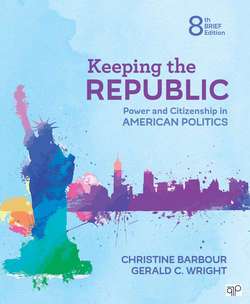Читать книгу Keeping the Republic - Christine Barbour - Страница 81
На сайте Литреса книга снята с продажи.
The Legislative Branch
ОглавлениеLegislative power is lawmaking power. The body of government that makes laws is called the legislature. The U.S. Congress is a bicameral legislature, meaning that there are two chambers—the House of Representatives and the Senate. Article I, by far the lengthiest article of the Constitution, sets out the framework of the legislative branch of government. Since the founders expected the legislature to be the most important part of the new government, they spent the most time specifying its composition, the qualifications for membership, its powers, and its limitations. The best-known part of Article I is the famous Section 8, which spells out the specific powers of Congress. This list is followed by the provision that Congress can do anything “necessary and proper” to carry out its duties. The Supreme Court has interpreted this clause so broadly that there are few effective restrictions on what Congress can do.
legislature the body of government that makes laws
bicameral legislature a legislature with two chambers
THE RULES The House of Representatives, where representation is based on population, was intended to be truly representative of all the people—the “voice of the common man,” as it were. To be elected to the House, a candidate need be only twenty-five years old and a citizen for seven years. Since House terms last two years, members run for reelection often and can be ousted fairly easily, according to public whim. The founders intended this office to be accessible to and easily influenced by citizens, and to reflect frequent changes in public opinion.
The Senate is another matter. Candidates have to be at least thirty years old and citizens for nine years—older, wiser, and, the founders hoped, more stable than the representatives in the House. Because senatorial terms last for six years, senators are not so easily swayed by changes in public sentiment. In addition, senators were originally elected by members of the state legislatures, not directly by the people. (This was changed by constitutional amendment in 1913.) Election by state legislators, themselves a “refinement” of the general public, would ensure that senators were a higher caliber of citizen: older and wiser but also more in tune with “the commercial and monied interest,” as Massachusetts delegate Elbridge Gerry put it at the Constitutional Convention.20 The Senate would thus be a more aristocratic body—that is, it would look more like the British House of Lords, where members are admitted on the basis of their birth or achievement, not by election.
THE NORMS The Constitution created two bodies that have to agree on a law in the exact same form for it to pass. But it does not also spell out the norms—the assumptions underlying those procedures. For instance, the founders assumed that legislating meant compromise. If they hadn’t wanted to force compromise, a unicameral legislature (a one-chambered legislature) would have been an easier way to go. They rejected that. Given that the authors of the Constitution themselves had to compromise with those who preferred the Articles of Confederation, we can infer that compromise is an important democratic norm. The founders also set up the Senate to be the older and more stable chamber. That means the founders expected more from senators, that they behave with more dignity than the more unruly House. Senators were expected to act like the adults in the room. Finally, the members of Congress were to be elected, so they intended that the results of fair elections would be recognized by all parties. This implies the norm of good sportsmanship, another way of saying that one occasionally has to be a good loser. When one side loses, it doesn’t take its marbles and go home. It doesn’t call the other side a cheater or say the win is illegitimate (unless it is). Instead, it accepts the loss knowing it will have another chance, another day.
